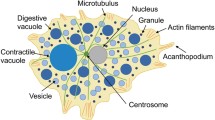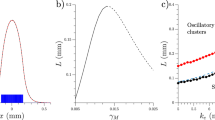Summary
The whole ectoplasmic layer of polytactic and heterotactic forms ofA. proteus behaves as self-contractile structure. Depending on the configuration of cell body and on the cell-to-substrate attachment conditions it continuously retracts from each distal cell projection toward its centre and/or from each free body end toward the actual adhesion sites. As in the monotactic forms, it leads to the withdrawal of the tail region behind the retraction center and may result in the fountain movement in front of it. In the long unattached pseudopodia of heterotactic forms the ectoplasm is retracted in the fountain form, with the velocity linearly increasing from the basis of pseudopodium up to its tip. In polytactic cells the fountain is often absent, if the advancing fronts immediately adhere to the substrate. When they develop in unattached condition, or are experimentally obliged to detach, the ectoplasmic cylinders of frontal pseudopodia are retracted backwards. On the substrates which do not offer firm points of support the cell periphery moves back as a whole,i.e., the principal ectoplasmic cylinder retracts together with the cylinders of lateral pseudopodia, and the direction and speed of movement in any spot is the resultant of forces produced by all other segments. The retraction of ectoplasmic gel layer is independent of the endoplasmic flow in such extent that a pseudopodium may be withdrawn as a whole in spite of the endoplasm streaming directed forwards in its interior. On the cell surface the particles attached by adhesion (glass rods) strictly follow the movements of the internal ectoplasmic structures, whereas the unattached particles flow forward in the direction of endoplasm streaming.
Similar content being viewed by others
References
Abercrombie, M., Heaysman, J. E. M., Pegrum, S. M., 1970: The locomotion of fibroblasts in culture. III. Movements of particles on the dorsal surface of the leading lamella. Exp. Cell Res.62, 389–398.
Allen, R. D., 1961 a: Ameboid movement. In: The cell, Vol. 2 (Brachet, J., Mirsky, A. E., eds.), pp. 135–216. New York-London: Academic Press.
—, 1961 b: A new theory of amoeboid movement and endoplasmic streaming. Exp. Cell Res. (Suppl.)8, 17–31.
—, 1973: Biophysical aspects of pseudopodium formation and retraction. In: The biology of amoeba (Jeon, K. W., ed.), pp. 201–247. New York-London: Academic Press.
Bell, L. G. E., Jeon, K. W., 1963: Locomotion ofAmoeba proteus. Nature198, 675–676.
Czarska, L., Grębecki, A., 1966: Membrane folding and plasmamembrane ratio in the movement and shape transformation inAmoeba proteus. Acta Protozool.4, 201–239.
Dellinger, O. P., 1906: Locomotion of amoebae and allied forms. J. exp. Zool.3, 337–358.
De Petris, S., Raff, M. C., 1973: Normal distribution, patching and capping of lymphocyte surface immunoglobulin studied by electron microscopy. Nature241, 257–259.
Grębecki, A., 1976: Coaxial motion of the semi-rigid cell frame inAmoeba proteus. Acta Protozool.15, 221–248.
—, 1980: Behaviour ofAmoeba proteus exposed to light-shade difference. Protistologica16, 103–113.
—, 1982 a: études expérimentales sur la localisation des fonctions motrices chez les amibes. Année Biol.21, 275–306.
- 1982 b: Supramolecular aspects of amoeboid movement. In: Progress in protozoology. Proc. VI Internat. Congr. Protozool., part 1, pp. 117–130.
—, 1984: Relative motion inAmoeba proteus in respect to the adhesion sites. I. Behaviour of monotactic forms and the mechanism of fountain phenomenon. Protoplasma123, 116–134.
—,Grębecka, L., 1978: Morphodynamic types ofAmoeba proteus: a terminological proposal. Protistologica14, 349–358.
Haberey, M., 1971: Bewegungsverhalten und Untergrundkontakt vonAmoeba proteus. Mikroskopie27, 226–234.
—,Wohlfarth-Bottermann, K. E., Stockem, W., 1969: Pinocytose und Bewegung von Amöben. VI. Kinematographische Untersuchungen über das Bewegungsverhalten der ZelloberflÄche vonAmoeba proteus. Cytobiologie1, 70–84.
Hellewell, S. B., Taylor, D. L., 1979: The contractile basis of ameboid movement. VI. The solation-contraction coupling hypothesis. J. Cell Biol.83, 633–648.
Jahn, T. L., 1964: Relative motion inAmoeba proteus. In: Primitive motile systems in cell biology (Allen, R. D., Kamiya, N., eds.), pp. 279–302. New York-London: Academic Press.
Mast, S. O., 1926: Structure, movement, locomotion and stimulation inAmoeba. J. Morphol.41, 347–425.
Nowakowska, G., Grębecki, A., 1978: Attachment ofAmoeba proteus to the substrate during upside-down crawling. Acta Protozool.17, 353–358.
Seravin, L. N., 1966: Ameboid locomotion. I. Arrest and resumption of the ameboid locomotion under some experimental conditions (in Russian with English summary). Zool. Zhurn.45, 334–341.
Stockem, W., Hoffmann, H. U., Gruber, B., 1983 a: Dynamics of the cytoskeleton inAmoeba proteus. I. Redistribution of microinjected fluorescein labeled actin during locomotion, immobilization and phagocytosis. Cell Tiss. Res.232, 79–96.
—,Naib-Majani, W., Wohlfarth-Bottermann, K. E., Osborn, M., Weber, K., 1983 b: Pinocytosis and locomotion of amoebae. XIX. Immunocytochemical demonstration of actin and myosin inAmoeba proteus. Eur. J. Cell Biol.29, 171–178.
—,Haberey, M., 1969: Pinocytose und Bewegung von Amöben. V. KonturverÄnderungen und Faltungsgrad der ZelloberflÄche vonAmoeba proteus. Cytobiologie1, 37–57.
Taylor, D. L., Blinks, J. R., Reynolds, G., 1980 a: Contractile basis of ameboid movement. VIII. Aequorin luminescence during ameboid movement, endocytosis, and capping. J. Cell Biol.86, 599–607.
—,Condeelis, J. S., 1979: Cytoplasmic structure and contractility in ameboid cells. Internat. Rev. Cytol.56, 57–144.
—,Hellewell, S. B., Virgin, H. W., Heiple, J., 1979: The solationcontraction coupling hypothesis of cell movement. In: Cell motility: Molecules and organization (Hatano, S., Ishikawa, H., Sato, H., eds.), pp. 363–367. Tokyo: University of Tokyo Press.
—,Hellewell, S. B., Virgin, H. W., Heiple, J., Wang, Y. L., 1980 b: Contractile basis of ameboid movement. VII. The distribution of fluorescently labeled actin in living amebas. J. Cell Biol.86, 590–598.
Taylor, R. B., Duffus, W. P. H., Raff, M. C., de Petris, S., 1971: Redistribution and pinocytosis of lymphocyte surface immunoglobulin molecules induced by anti-immunoglobulin antibody. Nature233, 225–229.
Wolpert, L., Gingell, D., 1968: Cell surface membrane and amoeboid movement. Symp. Soc. exp. Biol.22, 169–198.
Author information
Authors and Affiliations
Additional information
Study supported by Research Project II. 1 of the Polish Academy of Science.
Rights and permissions
About this article
Cite this article
Grębecki, A. Relative motion inAmoeba proteus in respect to the adhesion sites. Protoplasma 127, 31–45 (1985). https://doi.org/10.1007/BF01273699
Received:
Accepted:
Issue Date:
DOI: https://doi.org/10.1007/BF01273699




